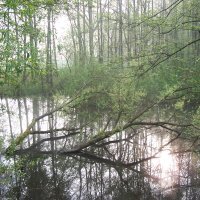 Bildrechte: B. Königstedt
Bildrechte: B. KönigstedtOxbow Lakes, Kolks and Seepage Water
The numerous, often very small bodies of water on the floodplain of the Elbe and also beyond the dyked areas represent extremely valuable habitats for a wide variety of species. They can be found throughout the lowlands of the valley, having been formed as drainage channels, through changes in the course of the river or by other means. Oxbow lakes and blind arms of the river show how dynamic the river’s history has been, and these bodies of water have filled up with varying degrees of silt and organic material in the course of time. At times of high water, large quantities of water are forced under the dykes by hydraulic pressure, reappearing on the other side in the form of temporary ponds and lakes. Some of the permanent waters to be found near the dykes on the side away from the river have come into being as a result of past breaches. These ponds are known as kolks and they, too, are fed by seepage water at flood time. There are also numbers of artificial lakes which came into existence on account of the dyke construction works or as claypits for the manufacture of tiles.
These habitats are rich in plant life. The most conspicuous of these are the white water lily (Nymphaea alba) and the yellow pond-lily (Nuphar lutea) – a few of the kolks near the dykes, and occasionally other ponds further away are covered with a yellow carpet formed by the fringed water lily (Nymphoides peltata). This plant is a river corridor plant, and the biosphere reserve represents the western border of its distribution range. Under certain conditions they almost completely disappear, but then the population generally recovers after a few years.
Some of the kolks provide a habitat for the water soldier (Stratiotes aloides). These plants have rosettes of sharply serrated leaves, so amongst many other common names they are known as water pineapple, water aloe or water saws. They were given the name ‘Krebsschere’ – crab’s claw – in German on account of the similar looking offshoots which they use for reproduction. The water soldiers grow in dense communities, each plant half submerged in the water. An endangered species of dragonfly, the green hawker (Aeshna viridis), is heavily dependent on this plant.
A large number of the seepage water ponds provide a refuge for rare or specialized species or those unable to cope with strong competition from others. Thus protected fish species such as the spined loach (Cobitis taenia) and the weather loach (Misgumus fossilis) have been found in such waters. Endangered amphibian species such as the fire bellied toad (Bombina bombina), the European tree frog (Hyla arborea), spadefoot toad (Pelobates fuscus), natterjack toad (Bufo calamita) and great crested newt (Triturus christatus) use them successfully as spawning waters. In addition, the larvae of many different kinds of dragonfly find the right conditions here – from the small red-eyed damselfly (Erythromma viridulum) and the southern emerald damselfly (Lestes barbarus) to the skimmer (Orthetrum spec.) and the migrant hawker (Aeshna mixta).
Two crustacean species – the tadpole shrimp (Lepidurus apus) and the Blattfußkrebs (Bosmina longirostris). have specialized in using the special conditions of the seepage water ponds, which only fill up with water for short periods. The reproductive cycle of these animals until egg-laying is only a few weeks long. After this, the eggs can survive for years without water in the pond, and when conditions improve for them the cycle can begin again.
 Bildrechte: B. Königstedt
Bildrechte: B. KönigstedtKolk near Predöhlsau



 deutsch
deutsch english
english